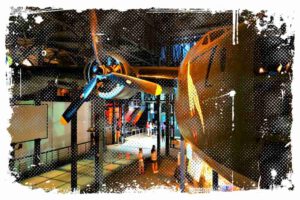If a place we’re visiting is declared a UNESCO World Heritage Site, we know there must be something special about it that makes it different from other locations. So, what exactly is UNESCO? It’s an organization of the United Nations that encourages collaboration among countries in the realms of art, culture and science to try and get rid of disparities between people based on their religion, skin color or social standing.

Poland has been a part of the UNESCO family since November 6, 1946, and is home to some amazing monuments that are listed on the World Heritage List. Ever wondered what incredible UNESCO sites are located in Poland? To give you an overview, I have compiled a list of these places here, along with a brief description. Furthermore, we have also connected these places to our detailed explanatory posts here on the blog. So, stay tuned, as there’s more to explore in the days to come.
UNESCO Monuments in Polish Cities
Poland is home to sixteen amazing sites that are part of the UNESCO World Heritage List. These places are truly one-of-a-kind and are becoming increasingly popular with tourists from around the globe, not just from the United States and Japan. Sadly, only six of them have been visited thus far – so let’s do something about that! Let’s get acquainted with all of the unique gems located in Poland. They are particularly:
- Krakow – Old Town – 1978
- Wieliczka and Bochnia – Royal Salt Mines – 1978
- Auschwitz-Birkenau – Nazi Concentration and Extermination Camp (1940-1945) – 1979
- Białowieża – Forest – 1979
- Warsaw – Old Town – 1980
- Zamość – Old Town – 1992
- Toruń – Medieval Urban Complex – 1997
- Malbork – Teutonic Castle – 1997
- Kalwaria – Zebrzydowska – 1999
- Jawor and Widnica – Peace Churches – 2001
- Wooden Churches of Southern Małopolska – 2003
- Muskau – Park – 2004
- Wrocław – Centennial Hall – 2006
- Wooden Churches in the Carpathian Mountains of Poland and Ukraine – 2013
- Tarnowskie Góry – Lead, Silver, and Zinc Mine, as well as the Underground Water Management System – 2017
- Krzemionki – Prehistoric Flint Mining Region – 2019
Krakow – Old Town – 1978
If you’re ever in Kraków, the former capital of Poland, you must take a trip to the historic Stare Miasto. It’s a 13th-century merchant town that boasts one of the largest market squares in Europe and a plethora of historic houses, palaces and churches that feature stunning interiors. Additionally, it also has remnants of 14th-century fortifications, medieval Kazimierz with its ancient synagogues, the Jagiellonian University and the Gothic cathedral where Polish kings were crowned. This site was officially added to the UNESCO list in 1978, so why not take a day to explore all the attractions of Cracow?
↳ PRO TIP: Do you like traveling? Then before you buy any ticket or book an attraction, check if it's available in this worldwide Viator Database. You may save a lot of money and time. No need to thank me :)
- Pictures and Location: Google Maps
Wieliczka and Bochnia – Royal Salt Mines – 1978
The salt mines of Wieliczka and Bochnia have been operational since the 13th century, granting them the distinction of being among the oldest of their kind in Europe and even being granted royal status. They not only represent the various stages of advancement in mining techniques across the continent, but they were also managed from the Zupna Castle in Wieliczka, which dates back to the Middle Ages and has been rebuilt several times since then.This incredible site was added to the UNESCO list in 1978. If you would like to know more about this fascinating place, visit the Wieliczka Salt Mine.
- Pictures and Location: Google Maps
Auschwitz-Birkenau – Nazi Concentration and Extermination Camp – 1979
Auschwitz-Birkenau, the largest concentration and extermination camp in the Third Reich, is a reminder of the horrible conditions under which the Nazi genocide occurred. As found by historical records, 1.5 million people, including a great number of Jews, were intentionally subjected to starvation, torture, and death. This camp serves as a symbol of the inhumane acts of mankind in the 1900s. UNESCO officially added the site to their list in 1979. If you plan to visit this place, I suggest you read my article about other surrounding cities worth visiting.
- Pictures and Location: Google Maps
Bialowieza – Forest – 1979
The Bialowieza Primeval Forest is a remarkable natural area spanning across the Polish-Belarusian border, covering 141,885 hectares. It is made up of both coniferous and deciduous trees and is located at the confluence of the Baltic and Black Seas. This place is a great place to visit, as it is home to the largest population of bison, a species that is highly iconic. UNESCO listed this area in 1979, so make sure to check out the sights to visit when in Bialowieza.
- Pictures and Location: Google Maps
Warsaw – Old Town – 1980
During World War II, the Nazis inflicted extensive damage to the city of Warsaw, with the destruction of more than 85% of its historic core. After the war, the people of Warsaw began a five-year effort to bring the Old Town, churches, palaces, and the market square back to life. This incredible restoration is a vivid reminder of the city’s past, covering a span of centuries from the 13th to 20th. Consequently, the site was added to the UNESCO list in 1980. Check out these 10 must-see spots in Warsaw.
- Pictures and Location: Google Maps
Zamosc – Old Town – 1992
Jan Zamoyski established Zamosc in the 16th century as a connection between Western and Northern Europe to the Black Sea. It was designed according to Italian theories of the perfect city, which were crafted by Paduan architect Bernardo Morando. Zamosc is a remarkable example of a Renaissance city from the late 16th century, retaining its original design and fortifications, as well as a mixture of Italian and Central European architecture. The site was designated a UNESCO World Heritage Site in 1992, and there is plenty things you can do there—check out the Zamosc attractions.
- Pictures and Location: Google Maps
Torun – Medieval Urban Complex – 1997
Torun’s beginnings can be traced back to the Order of the Hospital of the Blessed Virgin Mary of the German House in Jerusalem (Teutonic Order), which built a fortress there in the mid-13th century for the subjugation and spread of Christianity in Prussia. It quickly grew into a significant trading hub within the Hanseatic League. In both the Old and New Town, there are numerous impressive public and private constructions from the 14th and 15th centuries, including the home of Copernicus, which highlights Torun’s significance. This area was added to the UNESCO list in 1997.
- Pictures and Location: Google Maps
Malbork – Teutonic Castle – 1997
The Teutonic Order’s 13th-century castle was extended and embellished in 1309, when the Grand Master relocated to the site from Venice. It’s a magnificent instance of a medieval brick castle, though it slowly fell into disrepair until it was carefully renewed in the 19th and early 20th centuries. Innovative restoration methods, now accepted as the norm, were developed during this time. Subsequent to World War II, it was restored again using the existing documentation created by past conservators. Malbork Castle was added to the UNESCO list in 1997, and you can find all the necessary information regarding visiting the castle here.
- Pictures and Location: Google Maps
Kalwaria Zebrzydowska – 1999
Kalwaria Zebrzydowska is a remarkable cultural landscape that has maintained its spiritual importance since the early 17th century. The Mannerist architectural and park complex, combined with its picturesque natural environment, is home to many sacred sites related to the Passion of Jesus Christ and the life of the Virgin Mary. It is still a beloved pilgrimage spot and was added to the UNESCO World Heritage List back in 1999.
- Pictures and Location: Google Maps
Jawor and Swidnica – Churches of Peace – 2001
The Churches of Peace in Jawor and Widnica are the largest wooden places of worship in Europe. Constructed in the bygone times of Silesia during the mid-17th century, these edifices materialize the pursuit for religious autonomy amidst the religious strife that transpired after the Peace of Westphalia. Despite being subject to particular physical and political rules, the Peace Churches stand as a singular representation of the Lutheran ideology conforming to the Catholic Church. The site was officially included in the UNESCO list in 2001.
- Jawor Pictures and Location: Google Maps
- Swidnica Pictures and Location: Google maps
Binarowa, Blizne, Dębno, Haczów, Lipnica Murowana, Sękowa – Wooden churches – 2003
The churches of southern Lesser Poland made of wood are magnificent representations of the various aspects of medieval church-building practices within Roman Catholic culture. Utilizing the horizontal log technique, which is common in eastern and northern Europe, these churches were funded by noble families, acting as status symbols and as an alternative to the stone structures typically constructed in cities. These churches were granted UNESCO recognition in 2003.
- Pictures and Location: Google Maps
Muskauer (Mużakowski) Park – 2004
Mużakowski Park, located along the Neisse River and the Poland-Germany border, was founded by Prince Hermann von Puckler-Muskau and spans 559.9 hectares. It is a pioneering force in landscape design, having inspired architects all over Europe and America, and even includes a reconstructed castle, bridges, and an arboretum. In 2004, the extraordinary park was added to UNESCO’s list.
- Pictures and Location: Google Maps
Wroclaw – Centennial Hall – 2006
The Centennial Hall in Wroclaw is a remarkable milestone in the annals of reinforced concrete architecture. Constructed in the years 1911 and 1913 by architect Max Berg, the symmetrical building features a large central area that can house up to 6,000 people. The dome, which stands 23 meters high, is capped by a steel and glass lantern. This remarkable work of engineering and architecture is an exemplar of the mutual exchange of ideas that happened in the early 20th century, and it has since gone on to become a prominent reference in the further advancement of reinforced concrete designs. In 2006, the site was included on the UNESCO list.
- Pictures and Location: Google Maps
Carpathian Region – Wooden Orthodox Churches – 2013
From the 16th to the 19th century, Orthodox and Greek Catholic communities crafted churches out of horizontal wooden logs in the eastern portion of our nation. These places of worship boast an iconostasis, colorful inner decorations, and aged furnishings. Some of the churches contain wooden bell towers, cemeteries, and watchtowers, which are all integral components of the sites. Consequently, these sites were given a place on the UNESCO list in 2013.
- Pictures and Location: Google Maps
Tarnowskie Góry – Lead, Silver and Zinc Mine – 2017
Located in Upper Silesia, Tarnowskie Góry is one of the primary mining territories in Central Europe. It encompasses the whole subterranean mine with its access passages, shafts, tunnels, and other components of the water system. While the majority of the property is situated underground, the surface mine boasts vestiges of shafts, piles, and the remnants of a steam pumping station from the nineteenth century. The mine yields a noteworthy share of global lead and zinc. In 2017, the mine was included in the UNESCO list.
- Pictures and Location: Google Maps
Krzemionki – Prehistoric Striped Flint Mining – 2019
Krzemionki, located in the witokrzyskie mountain range, is a four-site complex dedicated to the extraction and refinement of striped flint from the Neolithic to the Bronze Age. Boasting underground mining facilities and flint workshops, this property has one of the most comprehensive underground flint mining and processing systems recognized to this day. The site sheds light on life and labor in prehistoric settlements, and serves as a vivid reminder of a bygone culture. It is an extraordinary reminder of the prehistoric period and the significance of flint mining for tool-making in human history.
- Pictures and Location: Google Maps
Bibliography
- https://www.unesco.pl/kultura/dziedzictwo-kulturowe/swiatowe-dziedzictwo/polskie-obiekty/
- https://www.polska.travel/pl/poznaj-atrakcje-i-zabytki/dziedzictwo-unesco



